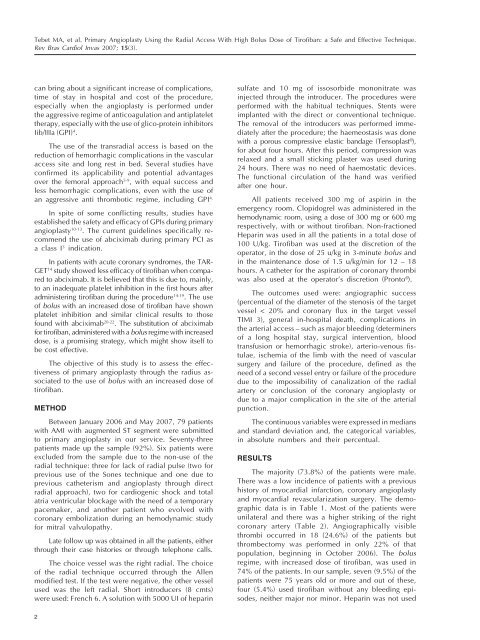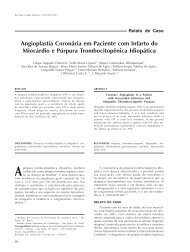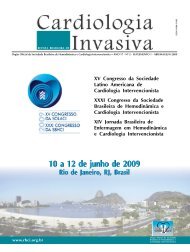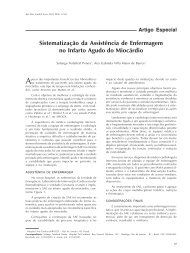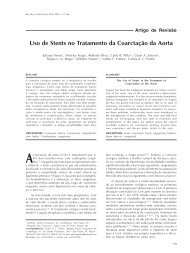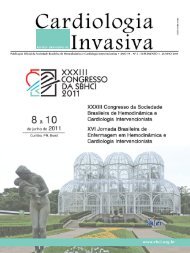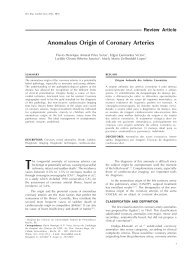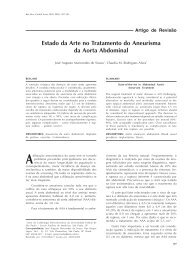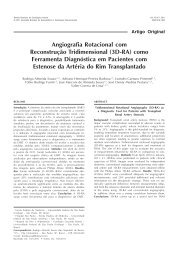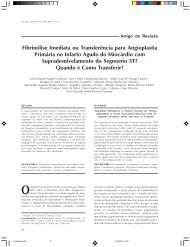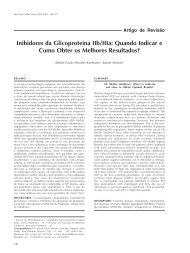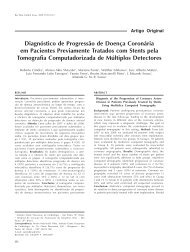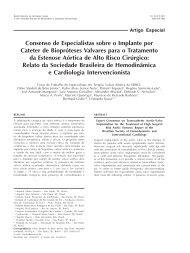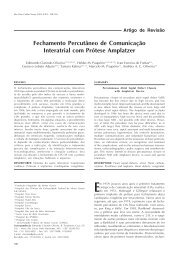Marden Tabet ING.pmd - Revista Brasileira de Cardiologia Invasiva
Marden Tabet ING.pmd - Revista Brasileira de Cardiologia Invasiva
Marden Tabet ING.pmd - Revista Brasileira de Cardiologia Invasiva
You also want an ePaper? Increase the reach of your titles
YUMPU automatically turns print PDFs into web optimized ePapers that Google loves.
Tebet MA, et al. Primary Angioplasty Using the Radial Access With High Bolus Dose of Tirofiban: a Safe and Effective Technique.<br />
Rev Bras Cardiol Invas 2007; 15(3).<br />
can bring about a significant increase of complications,<br />
time of stay in hospital and cost of the procedure,<br />
especially when the angioplasty is performed un<strong>de</strong>r<br />
the aggressive regime of anticoagulation and antiplatelet<br />
therapy, especially with the use of glico-protein inhibitors<br />
Iib/IIIa (GPI) 4 .<br />
The use of the transradial access is based on the<br />
reduction of hemorrhagic complications in the vascular<br />
access site and long rest in bed. Several studies have<br />
confirmed its applicability and potential advantages<br />
over the femoral approach 5-9 , with equal success and<br />
less hemorrhagic complications, even with the use of<br />
an aggressive anti thrombotic regime, including GPI 4.<br />
In spite of some conflicting results, studies have<br />
established the safety and efficacy of GPIs during primary<br />
angioplasty 10-13 . The current gui<strong>de</strong>lines specifically recommend<br />
the use of abciximab during primary PCI as<br />
a class I 3 indication.<br />
In patients with acute coronary syndromes, the TAR-<br />
GET 14 study showed less efficacy of tirofiban when compared<br />
to abciximab. It is believed that this is due to, mainly,<br />
to an ina<strong>de</strong>quate platelet inhibition in the first hours after<br />
administering tirofiban during the procedure 14-19 . The use<br />
of bolus with an increased dose of tirofiban have shown<br />
platelet inhibition and similar clinical results to those<br />
found with abciximab 20-22 . The substitution of abciximab<br />
for tirofiban, administered with a bolus regime with increased<br />
dose, is a promising strategy, which might show itself to<br />
be cost effective.<br />
The objective of this study is to assess the effectiveness<br />
of primary angioplasty through the radius associated<br />
to the use of bolus with an increased dose of<br />
tirofiban.<br />
METHOD<br />
Between January 2006 and May 2007, 79 patients<br />
with AMI with augmented ST segment were submitted<br />
to primary angioplasty in our service. Seventy-three<br />
patients ma<strong>de</strong> up the sample (92%). Six patients were<br />
exclu<strong>de</strong>d from the sample due to the non-use of the<br />
radial technique: three for lack of radial pulse (two for<br />
previous use of the Sones technique and one due to<br />
previous catheterism and angioplasty through direct<br />
radial approach), two for cardiogenic shock and total<br />
atria ventricular blockage with the need of a temporary<br />
pacemaker, and another patient who evolved with<br />
coronary embolization during an hemodynamic study<br />
for mitral valvulopathy.<br />
Late follow up was obtained in all the patients, either<br />
through their case histories or through telephone calls.<br />
The choice vessel was the right radial. The choice<br />
of the radial technique occurred through the Allen<br />
modified test. If the test were negative, the other vessel<br />
used was the left radial. Short introducers (8 cmts)<br />
were used: French 6. A solution with 5000 UI of heparin<br />
2<br />
sulfate and 10 mg of issosorbi<strong>de</strong> mononitrate was<br />
injected through the introducer. The procedures were<br />
performed with the habitual techniques. Stents were<br />
implanted with the direct or conventional technique.<br />
The removal of the introducers was performed immediately<br />
after the procedure; the haemeostasis was done<br />
with a porous compressive elastic bandage (Tensoplast ® ),<br />
for about four hours. After this period, compression was<br />
relaxed and a small sticking plaster was used during<br />
24 hours. There was no need of haemostatic <strong>de</strong>vices.<br />
The functional circulation of the hand was verified<br />
after one hour.<br />
All patients received 300 mg of aspirin in the<br />
emergency room. Clopidogrel was administered in the<br />
hemodynamic room, using a dose of 300 mg or 600 mg<br />
respectively, with or without tirofiban. Non-fractioned<br />
Heparin was used in all the patients in a total dose of<br />
100 U/kg. Tirofiban was used at the discretion of the<br />
operator, in the dose of 25 u/kg in 3-minute bolus and<br />
in the maintenance dose of 1.5 u/kg/min for 12 – 18<br />
hours. A catheter for the aspiration of coronary thrombi<br />
was also used at the operator’s discretion (Pronto ® ).<br />
The outcomes used were: angiographic success<br />
(percentual of the diameter of the stenosis of the target<br />
vessel < 20% and coronary flux in the target vessel<br />
TIMI 3), general in-hospital <strong>de</strong>ath, complications in<br />
the arterial access – such as major bleeding (<strong>de</strong>terminers<br />
of a long hospital stay, surgical intervention, blood<br />
transfusion or hemorrhagic stroke), arterio-venous fistulae,<br />
ischemia of the limb with the need of vascular<br />
surgery and failure of the procedure, <strong>de</strong>fined as the<br />
need of a second vessel entry or failure of the procedure<br />
due to the impossibility of canalization of the radial<br />
artery or conclusion of the coronary angioplasty or<br />
due to a major complication in the site of the arterial<br />
punction.<br />
The continuous variables were expressed in medians<br />
and standard <strong>de</strong>viation and, the categorical variables,<br />
in absolute numbers and their percentual.<br />
RESULTS<br />
The majority (73.8%) of the patients were male.<br />
There was a low inci<strong>de</strong>nce of patients with a previous<br />
history of myocardial infarction, coronary angioplasty<br />
and myocardial revascularization surgery. The <strong>de</strong>mographic<br />
data is in Table 1. Most of the patients were<br />
unilateral and there was a higher striking of the right<br />
coronary artery (Table 2). Angiographically visible<br />
thrombi occurred in 18 (24.6%) of the patients but<br />
thrombectomy was performed in only 22% of that<br />
population, beginning in October 2006). The bolus<br />
regime, with increased dose of tirofiban, was used in<br />
74% of the patients. In our sample, seven (9.5%) of the<br />
patients were 75 years old or more and out of these,<br />
four (5.4%) used tirofiban without any bleeding episo<strong>de</strong>s,<br />
neither major nor minor. Heparin was not used


